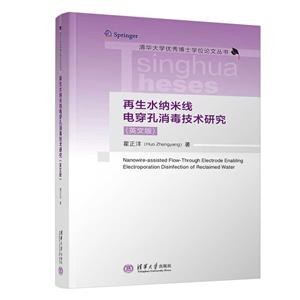-
>
湖南省志(1978-2002)?铁路志
-
>
公路车宝典(ZINN的公路车维修与保养秘籍)
-
>
晶体管电路设计(下)
-
>
基于个性化设计策略的智能交通系统关键技术
-
>
德国克虏伯与晚清火:贸易与仿制模式下的技术转移
-
>
花样百出:贵州少数民族图案填色
-
>
识木:全球220种木材图鉴
再生水纳米线电穿孔消毒技术研究(英文版) 版权信息
- ISBN:9787302617075
- 条形码:9787302617075 ; 978-7-302-61707-5
- 装帧:一般胶版纸
- 册数:暂无
- 重量:暂无
- 所属分类:>
再生水纳米线电穿孔消毒技术研究(英文版) 本书特色
《再生水纳米线电穿孔消毒技术研究(英文版)》研究工作解决了现有消毒技术效率低、微生物易复活、消毒副产物多等难题,具有重要的理论意义和应用价值。
再生水纳米线电穿孔消毒技术研究(英文版) 内容简介
《再生水纳米线电穿孔消毒技术研究(英文版)》基于多孔电极内部过滤处理模式开发了纳米线电穿孔消毒技术,可利用纳米线很好强电场实现在极低电压下对再生水中微生物的高效灭活。内容包括:1. 开发内部过滤纳米线电穿孔消毒技术,实现低电压安全消毒;2. 揭示纳米线电穿孔消毒技术可抑制灭活细菌复活的重要规律;3. 发现采用高频交流供电(10E6 Hz)模式可有效延长电极使用寿命。研究工作解决了现有消毒技术效率低、微生物易复活、消毒副产物多等难题,具有重要的理论意义和应用价值。 《再生水纳米线电穿孔消毒技术研究(英文版)》可供高等院校环境工程、市政工程、电化学等专业的研究人员使用,也可供相关领域的工程技术人员参考。
再生水纳米线电穿孔消毒技术研究(英文版) 目录
Chapter 1Introduction
1.1Research background
1.1.1Significance of wastewater reclamation
and reuse
1.1.2Necessity of wastewater reclamation
and reuse
1.1.3Challenges of the existing disinfection
technology
1.2Electroporation disinfection
1.2.1Electroporation for biomedical application
1.2.2Electroporation for water disinfection
1.3Current research status of novel electroporation
disinfection
1.3.1Nanowireassisted electroporation for water
disinfection
1.3.2Current reactor for nanowireassisted
electroporation disinfection
1.3.3Methods for insitu nanowire fabrication
1.3.4Impact of the nanowire morphology on
electroporation disinfection
1.3.5Nanomaterial strengthening method and electrode
lifetime improvement method
1.3.6Treatment efficiency of nanomaterialenabled
disinfection technology for reclaimed
wastewater
1.4Research topics to be further investigated
1.5Research objective and content
1.5.1Research objective
1.5.2Research content
1.5.3Research roadmap
Chapter 2Development of nanowiremodified electrodes and investigation
of the microbial inactivation performance
2.1Research background
2.2Experimental materials and methods
2.2.1Experimental reagents
2.2.2CuO nanowiremodified copper foam electrodes
fabrication and disinfection device
construction
2.2.3Characterization of CuO nanowiremodified
copper foam electrodes
2.2.4Microbes and water samples used in
experiments
2.2.5Nanowireassisted electroporation for microbial
disinfection
2.2.6Bacterial storage after nanowireassisted
electroporation disinfection
2.2.7Free chlorine detection and current detection
during nanowireassisted electroporation
disinfection
2.2.8Copper ion concentration detection
2.2.9Bacterial morphology analysis
2.2.10Bacterial staining experiments
2.3Fabrication of CuO nanowiremodified copper
foam electrodes
2.4Disinfection efficiency of CuO nanowiremodified copper
foam electrodes
2.4.1Disinfection efficiency of E.coli.
2.4.2Disinfection efficiency of E. faecalis, B.subtilis,
and secondary effluent from municipal wastewater
treatment plants
2.4.3Current fluctuations and free chlorine generation
during the disinfection process
2.5Bacterial inactivation mechanisms of nanowireassisted
electroporation disinfection
2.5.1Cell morphology analysis
2.5.2Bacterial staining analysis
2.6Bacterial population fluctuations during the storage
process after disinfection
2.6.1Bacterial population fluctuations during the
storage process
2.6.2Structural analysis of bacterial morphology
during storage after lowdosage nanowireassisted
electroporation disinfection
2.6.3Summary of the tendency of bacterial changes
during storage after disinfection
2.7Summary of this chapter
Chapter 3Effect of the nanowire morphology and electrode structure
on microbial inactivation
3.1Research background
3.2Experimental materials and methods
3.2.1Experimental reagents
3.2.2Preparation of porous electrodes modified with
nanowires of different morphologies
3.2.3Construction of nanowireassisted electroporation
disinfection devices with different electrode
structures
3.2.4Characterization of CuO nanowiremodified
copper foam electrode
3.2.5Microbes and water samples used in
experiments
3.2.6Nanowireassisted electroporation for microbial
disinfection
3.2.7Investigation of the disinfection contribution
of positive and negative electrode and
optimization of the reactor design
3.3Investigation on the effect of CuO nanowire morphology
on bacterial disinfection
3.3.1Factors impacting the morphology of
CuO
nanowires
3.3.2Study on the impact of CuO nanowire
morphology on bacterial disinfection
3.4Investigation on the effect of electrode structure on
bacterial disinfection
3.4.1Investigation of the effect of electrode pore
size on bacterial disinfection
3.4.2Investigation of the effect of electrode thickness
on bacterial disinfection
3.5Investigation on the effect of electrode arrangement
on bacterial disinfection
3.5.1Contribution of positive and negative electrodes
to microbial inactivation during nanowireassisted
electroporation disinfection
3.5.2Reactor optimization to enhance electroporation
disinfection efficiency
3.6Summary of this chapter
Chapter 4Fabrication of highdurability nanowiremodified electrodes
and investigation of their microbial
disinfection performance
4.1Research background
4.2Experimental materials and methods
4.2.1Experimental reagents
4.2.2Fabrication of Cu3P nanowiremodified copper
foam electrode
4.2.3Construction of nanowireassisted electroporation
disinfection devices
4.2.4Characterization and elemental analysis
of
nanowiremodified electrode
4.2.5Microbes and water samples used in
experiments
4.2.6Cu3P nanowireassisted electroporation for
microbial disinfection
4.2.7Analysis of microbial inactivation
mechanisms
4.2.8Analysis of the disinfection efficiency using
nanowiremodified electrodes for
longterm operation
4.2.9Analysis of the loss mechanism of electrode
during longterm operation
4.3Fabrication and characterization of Cu3P
nanowiremodified electrodes
4.3.1Fabrication of Cu3P nanowiremodified
electrodes
4.3.2Characterization of Cu3P nanowiremodified
electrodes
4.4Disinfection efficiency and mechanism of nanowire
assisted electroporation using Cu3P nanowiremodified
electrodes
4.4.1Disinfection efficiency of nanowireassisted
electroporation using Cu3P nanowiremodified
electrodes
4.4.2Disinfection mechanisms of nanowireassisted
electroporation using Cu3P nanowiremodified
electrodes
4.5Longterm disinfection performance and electrode
loss mechanism
4.5.1Longterm disinfection performance of Cu3P
nanowiremodified electrodes
4.5.2Electrode loss phenomenon during the
longterm operation
4.5.3Loss mechanism of Cu3P nanowiremodified
electrode
4.6Summary of this chapter
再生水纳米线电穿孔消毒技术研究(英文版) 作者简介
霍正洋,清华大学环境学院工学博士。现受Korea research fellowship资助于韩国成均馆大学先进材料科学与工程学院任研究教授。清华大学优秀博士毕业生。于高水平SCI期刊发表论文20余篇。研究领域:纳米材料在环境中应用,基于纳米发电机新型环境净化技术,高效消毒技术,再生水生物风险评价与控制。
-
民国时期的减灾研究(1912-1937)
¥20.4¥24 -
城市生活垃圾处理问与答
¥5.1¥3 -
城镇市容环境卫生建设标准汇编 垃圾分类、检测和收集转运卷
¥153¥180 -
建筑垃圾处理与处置
¥27.6¥70 -
人天之际:青藏高原生态与文化的互动研究
¥67¥88 -
生活垃圾分类与管理
¥59.5¥78





















